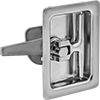Filter by
Latching Distance
Through-Hole Diameter
Opens With
Cam Latch Type
Mount Type
Latch Turn Direction
Finish
Straight Cam Length
Head Diameter
Offset Cam Length
Cam Type
Mounting Location
Environment
DFARS Specialty Metals
Building and Machinery Hardware
Containers, Storage, and Furniture


















































